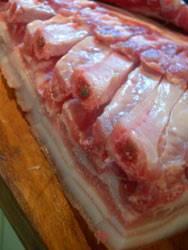Danny’s slow roast belly of pork to die for recipe
Posted by Fiona Nevile in Pork Ham Bacon Sausages | 143 comments
Joint of pork belly with skin side down ready for slow roast
We have Sunday Lunch in the evening and Danny usually cooks it. If I have the day off, I can spend hours in the garden and totter in at dusk to a great meal. Perfect.
Last week he cooked the best pork that I have ever tasted. I had bought belly of pork from Fred Fitzpatrick on a whim.
Danny was polite and definitely suspicious when I showed him the thin joint. Belly of pork is a slim, boy racer sort of cut. A rib of small bones and meat that appears to be stingy. Wrong. BOP has loads of meat.
I was working last weekend and arrived home to tantalising smells drifting from the oven.
“I found a great recipe. But didn’t have the ingredients so made up my own and experimented with a new method,” D explained, as he sliced the delicious meat.
The pork had a deep, mellow flavour and the crackling was truly superb. The skin and fat both took starring roles. Proper crackling underpinned by a sparkling melt in the mouth layer beneath. I was not eating ‘fat’ but gently roasted, bite sized pieces of heaven that had transmogrified in the long slow cooking process into something with texture and flavour. I would kill for a decent pork scratching. Danny’s home made version impressed me and after the first forkful of meat I reeled with applause and, I hate to admit it, envy.
Edit Oct 2015: Getting the crackling good and crispy can be a hit and miss affair. Every oven is different. See Sue’s comment below. If it’s rubbery, you can pop it under a low grill for 5 minutes or more but be careful not to let it blacken and burn. I guess it’s best to play safe and score it, and rub on salt and oil in the traditional manner.
Do also consider serving this perfect Yorkshire pudding recipe with this or any roast.
| Danny’s slow roast belly of pork to die for recipe |
- I kilo joint of belly of pork
- 10 leaves off a sprig of rosemary
- 3 small cloves of garlic sliced
- Foil big enough to form a nest under and around the joint
- Place the pork, crackling side down, in roasting pan. Distribute the rosemary and garlic evenly over the base of the belly. Take the foil and press it over the belly to make sure that the herbs will not shift.
- Turn the whole lot over, crackling side up, and form the foil into a snug nest around the joint, leaving the crackling exposed and ensuring that the fat from the crackling will drip into the foil nest.
- Roast at 140c (fan) for 3 hours and then turn down to 130c for another hour (4 hours!) – these are our fan-assisted oven temperatures so you may wish to adjust for a conventional oven, but not by much I think. Maybe +10% maximum.
Leave a reply






Hello Richard
Thank you so much for taking the trouble to leave your recipe. It sounds great and I have passed it onto D who is top Sunday chef at the cottage!
This recipe sounds fantastic. For all you pork belly fans, I thought I’d share my recipe with you (which is in the oven as I type!). Follow Danny’s way of cooking the pork, but instead of herbs and garlic, rub the pork with plenty of salt and chinese five spice powder, and roast for the same times as Danny suggests. Make a paste from five spice powder, a bit of sesame oil, and a splash of water, and brush the joint with this paste every hour throughout cooking.
When the joint has finished cooking, leave it to rest on a warm plate, then remove the crackling. Now, shred the meat with two forks (it should pull into lovely strands- don’t be tempted to eat them!) and mix with a jar of good hoi sin sauce. Return to the oven in a baking dish for 20-30 minutes at 200 degrees. You’ll end up with a beautiful caramelised, sticky pork.
Serve with plain steamed white rice and some purple sprouting broccoli.
Hi Terry and Chris
Thanks for the positive feedback, much appreciated!
absolutely delicious…did it a couple of weeks ago…
Hi JJ
Thanks for the tip. How did you modify your dustbin?
This is a good recipe. Now for all of you who like slow cooked joints like this, I beg of you to invest or build a charcoal fired hot smoker, the pork slow cooked and the flavour of the woodsmoke (whatever wood you like) is the nearest you will get to heaven. Here is a link, not that I am promoting it. Its just one of the best for this type of cookery. I used to use a modified dustbin and it worked great. The key is a water bath to catch the drips and prevent flare ups. As Danny has found, time is the key…http://virtualweberbullet.com/
Hi Madeleine
Thanks so much for sharing. Danny is going to try this next time.
Your mash and apple butter sound delicious accompaniments.
This recipe is great. I’ve done it twice so far and tried it today on 140 for 3 hours, 125 for 2 hours, then a quick minute or two under the grill at 200 to puff up the crackling. Worked a treat.
It is pure magic with red potato and wholegrain mustard mash and homemade apple butter.
Hi Kaye,
Thank you so much for leaving such a useful comment.
I checked with D and he double checked his temperatures. They are right for his dish. Perhaps the problem is a difference of oven temps.
You have left a comment that will pull round a flagging joint of pork. Thank you so much for your input.
Your recipe sounds great and I tried it out yesterday, but given what happened I think you may need to add some amendments? I am a pretty good cook, but after following your instructions to the letter, after three and three-quarter hours of cooking (in “ like yours – a fan-assisted oven, first at 140 and then at 130C as suggested), I found myself faced with a fairly unappetising, rubbery-looking mass of pork belly. It smelled good but showed no signs whatever of forming ˜proper crackling™. Recipes I™ve seen before say that for good crackling, you need to be using fairly high oven temperatures and so in desperation I lobbed a bit of salt over the skin-side of the pork, cranked up the heat to 220ËšC and left it to cook for about 30 minutes or so more. THEN I had the slow-roast pork belly with proper crackling to die for that you described “ it was exactly like your write-up suggested it would be “ the fat (like the meat) was obscenely delicious and it was all absolutely terrific. We will definitely be having this again, and thank you for the recommendation.
So my suggestion is: did you perhaps mean that the last hour of cooking should be at 230ËšC? (If so that does seem like a long time.)